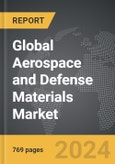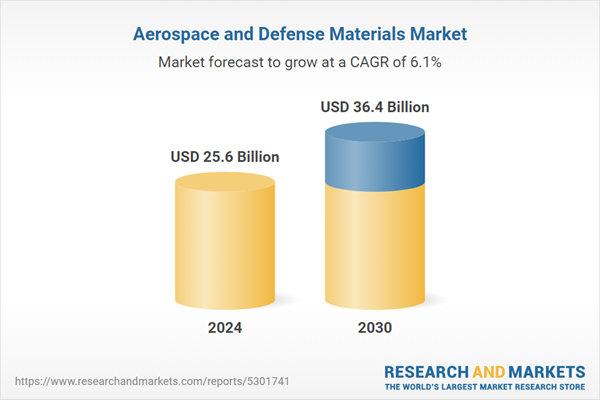Global Aerospace and Defense Materials Market - Key Trends & Drivers Summarized
Why Are Advanced Materials Crucial for the Aerospace and Defense Industry?
The aerospace and defense industries are at the forefront of technological innovation, and advanced materials play a pivotal role in driving performance, safety, and efficiency. From aircraft and spacecraft to military vehicles and defense systems, materials used in this sector must withstand extreme conditions, including high temperatures, pressure, and mechanical stress, while maintaining lightweight properties. Titanium alloys, carbon composites, and advanced ceramics are among the most sought-after materials, valued for their strength-to-weight ratio, durability, and resistance to corrosion. As the demand for fuel-efficient aircraft rises, lightweight materials are becoming indispensable, reducing operational costs and carbon footprints. Similarly, in defense, materials capable of absorbing impact and resisting advanced weaponry are essential, ensuring the reliability of military equipment in critical operations.How Is Technology Driving Innovation in Aerospace and Defense Materials?
Technological advancements are reshaping the landscape of aerospace and defense materials, enabling manufacturers to push the boundaries of performance. Additive manufacturing, or 3D printing, has revolutionized material fabrication, allowing for the creation of complex geometries and reducing waste. Nanotechnology is playing a transformative role, enhancing the strength, thermal resistance, and conductivity of materials at a molecular level. Smart materials, capable of self-healing or responding to environmental stimuli, are emerging as a game-changer in both aerospace and defense applications. Furthermore, advancements in material testing and simulation technologies are enabling engineers to assess material performance under simulated conditions, accelerating innovation and reducing development timelines. These technological strides are not only improving material capabilities but also enhancing the sustainability and cost-efficiency of production processes.What Trends Are Shaping the Aerospace and Defense Materials Market?
Several trends are influencing the aerospace and defense materials market, reflecting evolving industry priorities. The shift towards electric and hybrid aircraft is driving demand for advanced materials that support battery efficiency and lightweight construction. The rise of unmanned aerial vehicles (UAVs) and drones has created a niche market for specialized materials that combine lightweight properties with high durability. Environmental concerns are also shaping material selection, with increased focus on recyclability and the use of sustainable raw materials. In defense, the growing adoption of stealth technology is fueling demand for radar-absorbing materials and coatings that enhance operational security. The push for hypersonic weapons and vehicles has further underscored the need for materials capable of withstanding extreme heat and mechanical stress, reinforcing the sector's reliance on cutting-edge innovations.What Factors Are Driving Growth in the Aerospace and Defense Materials Market?
The growth in the aerospace and defense materials market is driven by several factors, including increasing investments in modernizing defense infrastructure and the rising demand for next-generation aircraft. Technological advancements, such as additive manufacturing and nanotechnology, are enabling the development of high-performance materials tailored to specific applications. The rapid expansion of commercial aviation in emerging economies is also boosting the demand for lightweight, fuel-efficient aircraft materials. Additionally, the growing emphasis on sustainability in aerospace and defense is encouraging the adoption of environmentally friendly materials and production methods. Rising geopolitical tensions and defense budgets are further driving demand for advanced materials in military applications, including armor, weapon systems, and surveillance equipment. These factors collectively highlight the critical role of innovative materials in addressing the challenges and opportunities of the aerospace and defense sectors.Report Scope
The report analyzes the Aerospace and Defense Materials market, presented in terms of units. The analysis covers the key segments and geographic regions outlined below.Segments: Material (Composites, Aluminum Alloys, Titanium Alloys, Superalloys, Steel Alloys, Other Materials); Application (Aerostructures Application, Components Application); End-Use (Commercial Aircraft End-Use, Military Aircraft End-Use, Business Aircraft End-Use, Other End-Uses).
Geographic Regions/Countries: World; USA; Canada; Japan; China; Europe; France; Germany; Italy; UK; Spain; Russia; Rest of Europe; Asia-Pacific; Australia; India; South Korea; Rest of Asia-Pacific; Latin America; Argentina; Brazil; Mexico; Rest of Latin America; Middle East; Africa.
Key Insights:
- Market Growth: Understand the significant growth trajectory of the Military Aircraft End-Use segment, which is expected to reach US$9.4 Billion by 2030 with a CAGR of a 4.2%. The BUsiness Aircraft End-use segment is also set to grow at 7.5% CAGR over the analysis period.
- Regional Analysis: Gain insights into the U.S. market, valued at $11.2 Billion in 2024, and China, forecasted to grow at an impressive 9.5% CAGR to reach $3.5 Billion by 2030. Discover growth trends in other key regions, including Japan, Canada, Germany, and the Asia-Pacific.
Why You Should Buy This Report:
- Detailed Market Analysis: Access a thorough analysis of the Global Aerospace and Defense Materials Market, covering all major geographic regions and market segments.
- Competitive Insights: Get an overview of the competitive landscape, including the market presence of major players across different geographies.
- Future Trends and Drivers: Understand the key trends and drivers shaping the future of the Global Aerospace and Defense Materials Market.
- Actionable Insights: Benefit from actionable insights that can help you identify new revenue opportunities and make strategic business decisions.
Key Questions Answered:
- How is the Global Aerospace and Defense Materials Market expected to evolve by 2030?
- What are the main drivers and restraints affecting the market?
- Which market segments will grow the most over the forecast period?
- How will market shares for different regions and segments change by 2030?
- Who are the leading players in the market, and what are their prospects?
Report Features:
- Comprehensive Market Data: Independent analysis of annual sales and market forecasts in US$ Million from 2024 to 2030.
- In-Depth Regional Analysis: Detailed insights into key markets, including the U.S., China, Japan, Canada, Europe, Asia-Pacific, Latin America, Middle East, and Africa.
- Company Profiles: Coverage of players such as Alcoa Corporation, Arconic Inc., ATI Materials, Constellium SE, Evonik Industries and more.
- Complimentary Updates: Receive free report updates for one year to keep you informed of the latest market developments.
Some of the 196 companies featured in this Aerospace and Defense Materials market report include:
- Alcoa Corporation
- Arconic Inc.
- ATI Materials
- Constellium SE
- Evonik Industries
- Hexcel Corporation
- Huntsman International LLC
- Kaiser Aluminum Corporation
- Kobe Steel, Ltd.
- Materion Corp.
- Novelis Inc.
- Rio Tinto Group
- SGL Carbon SE
- Solvay S.A.
- Strata Manufacturing PJSC
- TATA Advanced Systems Limited
- Teijin Carbon Europe GmbH
- Thyssenkrupp Aerospace Germany GmbH
- Toray Composite Materials America, Inc.
Tariff Impact Analysis: Key Insights for 2025
Global tariff negotiations across 180+ countries are reshaping supply chains, costs, and competitiveness. This report reflects the latest developments as of April 2025 and incorporates forward-looking insights into the market outlook.The analysts continuously track trade developments worldwide, drawing insights from leading global economists and over 200 industry and policy institutions, including think tanks, trade organizations, and national economic advisory bodies. This intelligence is integrated into forecasting models to provide timely, data-driven analysis of emerging risks and opportunities.
What’s Included in This Edition:
- Tariff-adjusted market forecasts by region and segment
- Analysis of cost and supply chain implications by sourcing and trade exposure
- Strategic insights into geographic shifts
Buyers receive a free July 2025 update with:
- Finalized tariff impacts and new trade agreement effects
- Updated projections reflecting global sourcing and cost shifts
- Expanded country-specific coverage across the industry
Table of Contents
Companies Mentioned (Partial List)
A selection of companies mentioned in this report includes, but is not limited to:
- Alcoa Corporation
- Arconic Inc.
- ATI Materials
- Constellium SE
- Evonik Industries
- Hexcel Corporation
- Huntsman International LLC
- Kaiser Aluminum Corporation
- Kobe Steel, Ltd.
- Materion Corp.
- Novelis Inc.
- Rio Tinto Group
- SGL Carbon SE
- Solvay S.A.
- Strata Manufacturing PJSC
- TATA Advanced Systems Limited
- Teijin Carbon Europe GmbH
- Thyssenkrupp Aerospace Germany GmbH
- Toray Composite Materials America, Inc.
Table Information
| Report Attribute | Details |
|---|---|
| No. of Pages | 769 |
| Published | April 2025 |
| Forecast Period | 2024 - 2030 |
| Estimated Market Value ( USD | $ 25.6 Billion |
| Forecasted Market Value ( USD | $ 36.4 Billion |
| Compound Annual Growth Rate | 6.1% |
| Regions Covered | Global |









